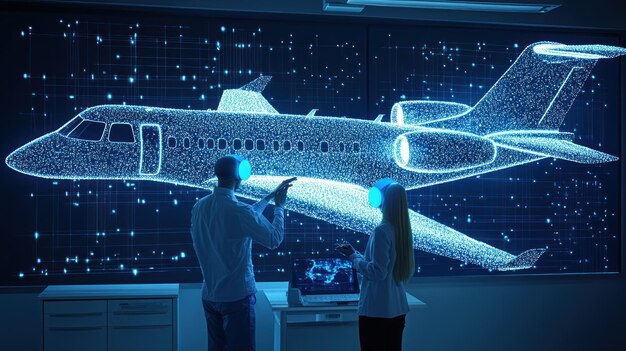In modern aviation, the complexity of aircraft systems continues to grow, with multiple avionics, communication, navigation, and control systems working together to ensure safe and efficient flight operations.
As these systems become more advanced, the need for seamless integration and interoperability has never been greater. This is where ARINC (Aeronautical Radio, Incorporated) standards play a crucial role.
ARINC standards provide a set of guidelines and protocols that ensure compatibility between various systems and equipment on board an aircraft, regardless of the manufacturer.
By defining clear communication interfaces, data formats, and protocols, ARINC standards help integrate diverse technologies, making them work together smoothly. This interoperability is essential for reducing system errors, improving reliability, and ensuring the safety of both passengers and crew.
In this blog, we will explore the role of ARINC standards in aircraft system integration and how they enable efficient, reliable, and safe aviation operations.

Role of ARINC Standards in Aircraft System Integration
ARINC standards play a vital role in ensuring that the various systems and subsystems within an aircraft can work together efficiently. In modern aircraft, avionics, flight controls, communication systems, and other critical technologies must communicate seamlessly to ensure safety, performance, and reliability. ARINC standards provide the framework for this integration, enabling smooth interaction between systems from different manufacturers.

1. Standardized Communication Protocols
One of the core features of ARINC standards is the establishment of standardized communication protocols. These protocols define how data is exchanged between systems, such as flight management systems, engine control units, radar, and cockpit displays. For example, ARINC 429 is a widely used protocol that facilitates one-way communication between avionics systems, ensuring reliable data transfer. By standardizing these protocols, ARINC eliminates potential compatibility issues that may arise when integrating systems from different suppliers.
2. Data Format Standardization
Aircraft systems often produce and exchange vast amounts of data, from sensor readings to flight path information. ARINC standards define the format and structure of this data, ensuring that all systems interpret it correctly. For instance, ARINC 664, used for Ethernet-based communication, specifies the data format for higher-speed transmission, allowing for large data sets to be exchanged efficiently. This standardization allows engineers to design systems that can easily interact with one another, reducing the risk of data misinterpretation or loss.
3. Interfacing Avionics Systems
The integration of avionics systems is another critical area where ARINC standards play a key role. These systems include flight control, navigation, communication, and surveillance systems that must work in tandem. ARINC provides standardized interfaces, making it easier for manufacturers to develop and integrate components from different vendors. For example, ARINC 453, a standard for aircraft communication systems, ensures that avionics equipment can be interconnected, making system integration much more efficient.
4. Reduced System Integration Time and Costs
By adhering to ARINC standards, manufacturers can reduce the time and cost associated with integrating complex aircraft systems. With standardized communication protocols and data formats in place, there is no need to develop custom interfaces for each new system or component. This not only speeds up the development and certification process but also makes it easier for maintenance teams to upgrade or replace systems without disrupting the overall integration.

5. Ensuring Compatibility Across Multiple Manufacturers
Modern aircraft often feature systems and components from multiple manufacturers, which can create compatibility challenges. ARINC standards ensure that equipment from different vendors can communicate effectively and integrate smoothly. This interoperability is essential for large commercial aircraft, where various subsystems from different suppliers must be unified into a single operational platform. Without these standards, aircraft manufacturers would face significant challenges in ensuring compatibility and avoiding costly redesigns.
Benefits of ARINC Standards
ARINC standards offer numerous advantages that contribute to the efficiency, safety, and cost-effectiveness of modern aircraft systems. These benefits extend to both manufacturers and operators, making ARINC standards essential for the seamless operation of complex aviation systems. Below are some of the key benefits:

1. Enhanced Safety and Reliability
Safety is the top priority in aviation, and ARINC standards help ensure that all systems within an aircraft function as intended, with minimal risk of failure. By standardizing communication protocols and data formats, ARINC reduces the likelihood of miscommunication or errors between systems. This standardization ensures that critical systems, such as navigation, flight control, and communication, can reliably share information and work together. The result is a higher level of safety for passengers and crew.
2. Simplified System Integration
ARINC standards simplify the integration of various systems within an aircraft. By providing predefined communication interfaces and data structures, these standards eliminate the need for custom integration solutions, which can be time-consuming and prone to errors. Manufacturers can design and implement systems more efficiently, knowing that they will meet established interoperability requirements. This ease of integration is particularly valuable in complex, multi-vendor environments, where different systems must communicate effectively.
3. Cost Savings
The use of ARINC standards leads to significant cost savings throughout the lifecycle of an aircraft. During the design and development phase, manufacturers can rely on established standards, reducing the need for custom solutions and accelerating time to market. Additionally, ARINC’s standardized approach to system integration reduces the risk of compatibility issues, which could lead to costly rework or system redesigns. Over time, maintenance costs are also lowered, as standardized systems are easier to troubleshoot, upgrade, and replace.
4. Interoperability Across Multiple Vendors
Modern aircraft typically include systems and components from a variety of vendors, and ensuring interoperability between these components is crucial. ARINC standards provide a common framework that allows equipment from different manufacturers to work together seamlessly. This is especially important for large aircraft programs, where systems from multiple suppliers must be integrated into a unified platform. By ensuring that all systems communicate effectively, ARINC standards facilitate smoother collaboration between different suppliers and reduce integration challenges.
5. Future-Proofing Aircraft Systems
As technology evolves, the aviation industry must adapt to new systems and innovations. ARINC standards are designed with flexibility in mind, enabling them to accommodate emerging technologies. For instance, newer standards like ARINC 664P7, based on Ethernet, support higher-speed data transfer, making it easier to integrate modern, data-intensive systems. This adaptability ensures that aircraft systems can remain compatible with future advancements, extending the longevity and relevance of ARINC-compliant systems.
6. Simplified Maintenance and Upgrades
One of the most significant benefits of ARINC standards is the ease of maintenance and system upgrades. Since all systems follow standardized protocols, maintenance teams can quickly diagnose issues, replace faulty components, or perform software updates. This standardization also allows for the easier introduction of new technologies, as components that meet ARINC standards can be integrated with minimal disruption to existing systems. For example, when upgrading avionics or communication systems, the new components can be seamlessly integrated with older systems, reducing downtime and operational impact.
7. Certification and Compliance
Aircraft systems must undergo rigorous certification processes to meet regulatory requirements. ARINC standards play a vital role in simplifying this process by providing well-established guidelines for system design and integration. Manufacturers can more easily demonstrate compliance with regulatory bodies such as the FAA (Federal Aviation Administration) or EASA (European Union Aviation Safety Agency) by adhering to ARINC standards. This not only speeds up the certification process but also reduces the risk of non-compliance.
8. Improved Performance and Efficiency
ARINC standards help optimize the performance of aircraft systems by ensuring that they can efficiently communicate and share data. Standardized communication protocols, such as ARINC 664 for high-speed Ethernet communication, enable systems to transmit large volumes of data quickly and reliably. This improved performance supports the operational efficiency of the aircraft, whether it’s for navigation, weather monitoring, or engine diagnostics.

Conclusion
In summary, ARINC standards are essential for ensuring the seamless integration and interoperability of complex systems within modern aircraft. By providing standardized communication protocols, data formats, and interfaces, ARINC enables diverse systems from multiple vendors to work together reliably, improving safety, performance, and overall system efficiency. These standards reduce the risk of integration issues, streamline development and maintenance processes, and help minimize costs, making them a crucial aspect of the aviation industry.
As technology continues to evolve, ARINC standards remain adaptable, supporting the integration of new, advanced systems while maintaining compatibility with legacy technologies. With their proven ability to ensure safety, reduce costs, and simplify system integration, ARINC standards will continue to play a pivotal role in the development of next-generation aircraft, ensuring that they remain safe, efficient, and ready for the future.







